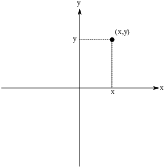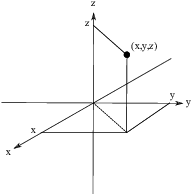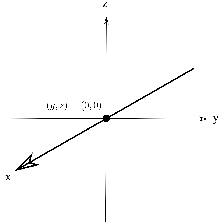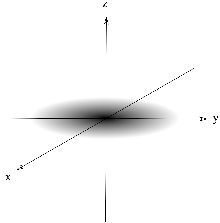The real numbers are denoted by ![]() . I'll assume you're familiar with the basic
properties of
. I'll assume you're familiar with the basic
properties of ![]() , but I'll mention less familiar things as
they come up.
, but I'll mention less familiar things as
they come up.
The standard 2-dimensional plane is denoted ![]() . It consists of ordered pairs of real numbers:
. It consists of ordered pairs of real numbers:
![]()
You're probably familiar with how a point ![]() is located in the plane:
is located in the plane:

The "x" and "y" on the axes label the positive x-axis and positive y-axis.
Similarly, 3-dimensional space is denoted ![]() . It consists of ordered triples of real numbers:
. It consists of ordered triples of real numbers:
![]()
(There are also ![]() ,
, ![]() , and so on,
defined in similar fashion.)
, and so on,
defined in similar fashion.)
Just as it's conventional to use x and y to denote the first and
second coordinate variables in ![]() , it is
conventional to use x, y, and z to denote the first, second, and
third coordinate variables in
, it is
conventional to use x, y, and z to denote the first, second, and
third coordinate variables in ![]() . The picture
shows how a typical point
. The picture
shows how a typical point ![]() is located in space:
is located in space:

The "x", "y", and "z" on the axes label the positive x-axis, the positive y-axis, and the positive z-axis.
At this point, I should note a convention that we'll always follow.
The labelling of the positive axes in ![]() and
and ![]() follow the "right-hand
rule". In the x-y-plane, you curl the fingers of your
right hand from the positive x-axis to the positive y-axis
through a
follow the "right-hand
rule". In the x-y-plane, you curl the fingers of your
right hand from the positive x-axis to the positive y-axis
through a ![]() angle. Check for yourself with the picture
above.
angle. Check for yourself with the picture
above.
(Note that in some computer graphics applications --- for instance, in the SVG graphics language --- it's conventional to have the positive y-axis going "downward" rather than "upward".)
For ![]() , curl the fingers of your right
hand from the positive x-axis to the positive y-axis. As you do so,
your thumb points in the direction of the positive z-axis. Check for
yourself with the picture above.
, curl the fingers of your right
hand from the positive x-axis to the positive y-axis. As you do so,
your thumb points in the direction of the positive z-axis. Check for
yourself with the picture above.
Graphing things in 3 dimensions is obviously harder than graphing
things in 2 dimensions. While you don't need to have great artistic
skills, you should practice making diagrams in 3 dimensions as they
are a huge aid to understanding. Short of taking a drawing class, the
best approach might be to copy other peoples' pictures until you get
the idea. For starters, you can practice plotting points in ![]() .
.
Example. Plot the points ![]() ,
, ![]() , and
, and ![]() . The pictures below aren't perfectly scaled; I just
want to locate the points in approximately the right places.
. The pictures below aren't perfectly scaled; I just
want to locate the points in approximately the right places.

The axes and the coordinate planes. Consider
the x-axis. It is perpendicular to the y-z plane, and passes through
the origin ![]() of the y-z-plane. Therefore, it is
determined by the equations
of the y-z-plane. Therefore, it is
determined by the equations
![]()

I'll discuss lines later on, and in particular their equations in parametric form. The parametric equations for the x-axis are
![]()
Similarly, the y-axis is
![]()
The z-axis is
![]()
Now consider the x-y plane. It consists of all the points at
"z-level" zero --- that is ![]() .
.

Likewise, the y-z plane is ![]() , and the x-z plane is
, and the x-z plane is ![]() .
.
Distance. The distance between points ![]() and
and ![]() is given
by
is given
by
![]()
(You can write "![]() ", and so on,
instead; the squaring makes the order of subtraction irrelevant.)
", and so on,
instead; the squaring makes the order of subtraction irrelevant.)
Here's where the formula comes from.

The box has sides of lengths ![]() ,
, ![]() , and
, and ![]() . By Pythagoras' Theorem,
the diagonal s of the bottom of the box is
. By Pythagoras' Theorem,
the diagonal s of the bottom of the box is
![]()
I can drop the absolute values because I'm squaring the terms.
Again by Pythagoras' Theorem, the distance is
![]()
Example. Find the distance between the points
![]() and
and ![]() .
.
![]()
Copyright 2017 by Bruce Ikenaga